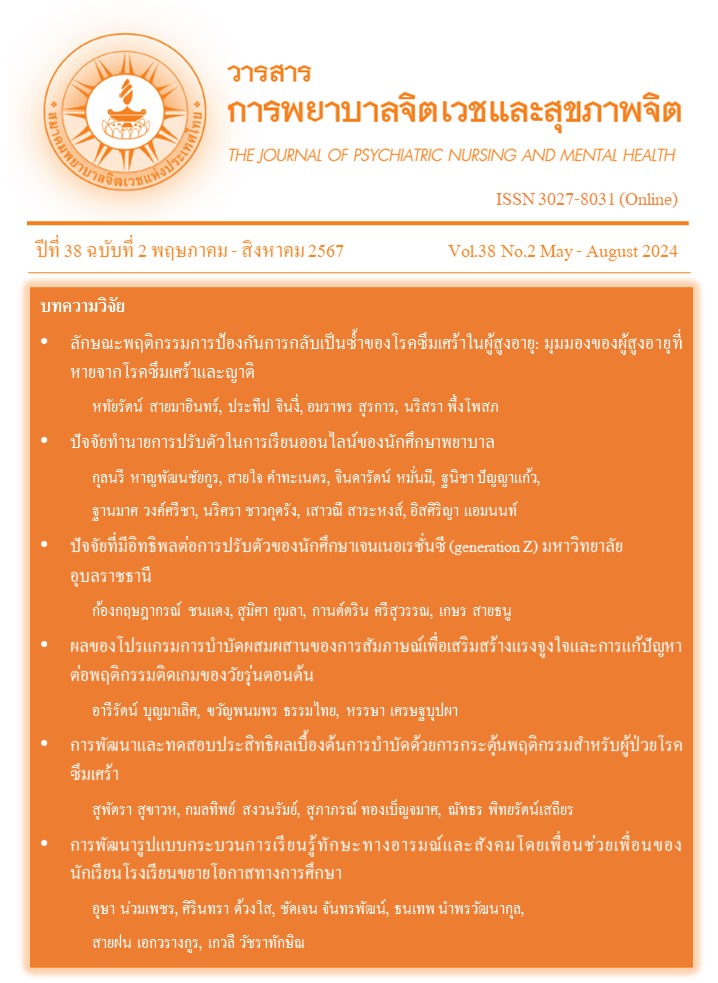การพัฒนารูปแบบกระบวนการเรียนรู้ทักษะทางอารมณ์และสังคมโดยเพื่อนช่วยเพื่อนของนักเรียนโรงเรียนขยายโอกาสทางการศึกษา
Main Article Content
บทคัดย่อ
วัตถุประสงค์ : เพื่อพัฒนารูปแบบกระบวนการเรียนรู้ทักษะทางอารมณ์และสังคมโดยเพื่อนช่วยเพื่อนของนักเรียนโรงเรียนขยายโอกาสทางการศึกษา และศึกษาการเปลี่ยนแปลงด้านทักษะทางอารมณ์และสังคมของนักเรียนและการเรียนรู้ของผู้บริหารและครูที่เข้าร่วมกิจกรรมกระบวนการเรียนรู้ทักษะทางอารมณ์และสังคมโดยเพื่อนช่วยเพื่อน
วิธีการศึกษา : วิจัยเชิงปฏิบัติการ แบ่งเป็น 3 ระยะ 1) เริ่มต้นการวิจัย : การวางแผน 2) ดำเนินการวิจัย : การปฏิบัติ และ 3) สิ้นสุดการวิจัย : สังเกตและสะท้อนกลับ กลุ่มเป้าหมาย คือนักเรียนแกนนำมัธยมศึกษาปีที่ 2 - 3 จำนวน 15 คน นักเรียนที่ได้รับการขยายผลชั้นประถมศึกษาปีที่ 1 - 4 จำนวน 50 คน ผู้บริหารและครูประจำระดับชั้นจำนวน 5 คน เลือกแบบเจาะจงจากโรงเรียนขยายโอกาสทางการศึกษาแห่งหนึ่ง รวบรวมข้อมูลด้วยการสนทนากลุ่ม การสัมภาษณ์ การสังเกต วิเคราะห์ข้อมูลโดยแจกแจงความถี่ ร้อยละ ค่าเฉลี่ย ส่วนเบี่ยงเบนมาตรฐาน และการวิเคราะห์เนื้อหา
ผลการศึกษา : รูปแบบกระบวนการเรียนรู้ทักษะทางอารมณ์และสังคมโดยเพื่อนช่วยเพื่อนของนักเรียนมีโครงสร้าง 3 กลุ่ม คือ นักเรียนแกนนำ ผู้บริหาร ครูประจำระดับชั้น ดำเนินงานร่วมกัน 3 ระยะ ระยะที่ 1 มุ่งทำความเข้าใจสถานการณ์ พัฒนาแผนการดำเนินงาน มอบหมายหน้าที่ ระยะที่ 2 พัฒนาแกนนำนักเรียนและเปิดพื้นที่ขยายผลสู่กลุ่มเพื่อนตามแผนด้วยการเรียนรู้ผ่านประสบการณ์และการโค้ช ระยะที่ 3 การสังเกตและสะท้อนการปฏิบัติในพื้นที่ ผลการใช้รูปแบบพบว่านักเรียนแกนนำเกิดภาวะผู้นำ รู้สึกมีคุณค่าจากการส่งต่อ เพื่อนนักเรียนเกิดการพัฒนาทักษะทางอารมณ์และสังคม ผู้บริหารและครูยอมรับศักยภาพนักเรียน เกิดแนวทางพัฒนานักเรียนในโรงเรียน
สรุป : กระบวนการเพื่อนช่วยเพื่อนสามารถพัฒนาทักษะทางอารมณ์และสังคมของนักเรียน
Article Details

อนุญาตภายใต้เงื่อนไข Creative Commons Attribution-NonCommercial-NoDerivatives 4.0 International License.
บทความที่ได้รับการตีพิมพ์แล้ว เป็นลิขสิทธิ์ของสมาคมพยาบาลจิตเวชแห่งประเทศไทย
เอกสารอ้างอิง
กรรณิการ์ กำธร. (2557). ผลของการใช้โปรแกรมพัฒนาความ สามารถในการเรียนรู้ทางอารมณ์และสังคมของนักเรียนระดับชั้นมัธยมศึกษาปีที่ 2 โรงเรียนสตรีวัดระฆัง [วิทยานิพนธ์ปริญญามหาบัณฑิต]. มหาวิทยาลัยศรีนครินทรวิโรฒ.
นครินทร์ สุวรรณแสง, ปิยะนุช จิตตนูนท์, และ กาญจน์สุนภัส บาลทิพย์. (2562). ผลของโปรแกรมการพัฒนาทักษะชีวิตต่อความฉลาดทางอารมณ์ของวัยรุ่นหญิงในสถานสงเคราะห์เด็ก. วารสารพยาบาลสงขลานครินทร์, 38(1), 22-34.
มนตรี อินตา และสุพัตรา สกุลศรีประเสริฐ. (2561). การเรียนรู้ทางอารมณ์และสังคมตามแนวคิดของ CASEL ของนักเรียนมัธยมศึกษาตอนต้น สังกัดสำนักงานคณะกรรมการการศึกษาขั้นพื้นฐาน. วารสารศรีนครินวิโรฒ วิจัยและพัฒนา, 10(20), 98-116.
รวิพรรดิ พูลลาภ และอาจินต์ สงทับ. (2563). บทบาทของเพื่อนในการช่วยเพื่อนวัยรุ่นที่มีภาวะซึมเศร้า. พุทธชินราชเวชสาร, 37(3), 368-377.
รังสิรัศม์ นิลรัตน์. (2553). การพัฒนาโปรแกรมการเรียนรู้ทางอารมณ์และสังคมสำหรับนักเรียนประถมศึกษาปีที่ 4-6 [วิทยานิพนธ์ปริญญามหาบัณฑิต]. จุฬาลงกรณ์มหาวิทยาลัย.
สำนักงานคณะกรรมการการศึกษาขั้นพื้นฐาน กระทรวงศึกษาธิการ. (2558). รายงานประจำปี 2558.
สำนักงานเลขาธิการสภาการศึกษา กระทรวงศึกษาธิการ. (2560). แผนการศึกษาแห่งชาติ พ.ศ.2560-2579. พริกหวานกราฟฟิค.
สุภารัตน์ พัฒนแหวว (2564). การเสริมสร้างการเรียนรู้ทางอารมณ์ของนักเรียนมัธยมศึกษาตอนต้นโดยการปรึกษากลุ่ม. วารสารศึกษาศาสตร์ มมร, 9(2), 42-53.
American Psychological Association. (2002). Developing adolescent: A reference for professionals. https://www.apa. org/pi/families/resources/develop.pdf
Caver, S. E. (2022). Exploring the implementation of social-emotional learning through the lens of King’s managing complex change model [Doctoral dissertation, Southern Nazarene University]. ProQuest. https://www.proquest. com/openview/dae81d8dc5a32ce30e1f4a34731d5ab9/1?pq-origsite=gscholar&cbl=18750&diss=y
Collaborative for Academic, Social, and Emotional Learning. (2022). Indicators of Schoolwide SEL. https://schoolguide. casel.org/what-is-sel/indicators-of- schoolwide-sel/
Dawson, P., van der Meer, J., Skalicky, J., & Cowley, K. (2014). On the effectiveness of supplemental instruction: A systematic review of supplemental instruction and peer-assisted study sessions literature between 2001 and 2010. Review of Educational Research, 84(4), 609-639.
Durlak, J. A., Weissberg, R. P., Dymnicki, A. B., Taylor, R. D., & Schellinger, K. B. (2011). The impact of enhancing students’ social and emotional learning: A meta-analysis of school based universal interventions. Child Development, 82(1),405-432.
Gao, Y., & Liang, X. (2020). The relationship between academic success or failure, self-esteem and learning burnout of junior high school students. Mental Health Education in Primary and Secondary School, 17, 17-20.
Greenberg, M., Domitrovich, C., Weissberg, R., & Durlak, J. (2017). Social and emotional learning as a public health approach to education. The Future of Children, 27(1), 13-32.
Hagelskamp, C., Brackett, M. A., Rivers, S. E., & Salovey, P. (2013). Improving classroom quality with the ruler approach to social and emotional learning: Proximal and distal outcomes. American Journal of Community Psychology, 51, 530–543.
Hamilton, S. L., Doss, J. C., & Steiner, D. E. (2019). Support for Social and Emotional Learning Is Widespread: Principals and Teachers Give Insight into How They Value, Address, and Measure It, and Which Supports They Need. RAND Corporation. https://www.rand.org/pubs/research_ briefs/RB10064.html
Jackson, E. E., Porter, C. S., Easton, Q. J., Blanchard, A. & Kiguel, S. (2020). School effects on socioemotional development, school-based arrests, and educational attainment American economic review, American Economic Association, 2(4), 491-508.
Jones, S. M., Barnes, S. P., Bailey, R. & Doolittle, E. J. (2017). Promoting social and emotional competencies in elementary school. Future of Children, 27(1), 49-72.
Kemmis, S & McTaggart, R. (1988). The Action Research Planer (3rd ed.). Deakin University.
Kremer, K. P., Maynard, B. R., Polanin, J. R., Vaughn, M. G., & Sarteschi, C. M. (2015). Effects of after-school programs with at-risk youth on attendance and externalizing behaviors: A systematic review and meta-analysis. Journal of Youth and Adolescence, 44(3), 616-636.
Lester, A. M., Chow, J. C., & Melton, T. N. (2020). Quality is critical for meaningful synthesis of afterschool program effects: a systematic review and meta-analysis. Journal of Youth and Adolescence, 49(2), 369-382.
Lim, L, C., Jalil, A, H., Ma’rof, M, A., & Saad, Z, W. (2020). Peer learning, self-regulated learning and academic Achievement in blended learning courses: A structural equation modeling approach. International Journal of Emerging Technologies in Learning, 15(3), 110-125.
Low, S., Smolkowski, K., & Cook, C. (2016). What constitutes high-quality implementation of SEL programs.? A latent class analysis of Second Step implementation. Prevention Science, 17(8): 981-991.
Prothero, A. (2020). The Secret to Improving Students’ Social-Emotional Skills? Start With the Adults. Education Week. https://www.edweek.org/leadership/the-secret-to-improving-students-social-emotional-skills-start-with-the-adults/2020/10
Schwartz, H. L., Hamilton, L. S., Mills, S. F., Gomez, C. J., Huguet, A., Jaycox, L. H., Leschitz, J. T., Tuma, A. P., Tosh, K., Whitaker, A. A., & Wrabel, S. W. (2020). Early lessons from Schools and Out-of-School Time Programs Implementing Social and Emotional Learning. RAND Corporation. https://doi.org/10.7249/RRA379-3
Stigmar, M. (2016). Peer-to-peer teaching in higher education: A critical literature review. Mentoring & Tutoring: Partnership in Learning, 24(2),
United Nations Children’s Fund. (2021). The State of the World’s Children 2021: On my mind-promoting, protecting and caring for children’s mental health. https://www.unicef.org/ media/114636/file/SOWC-2021-full- report English.pdf.


